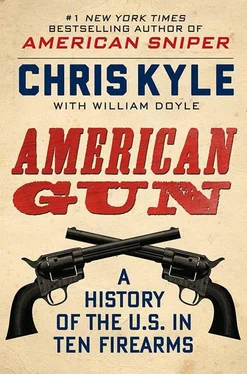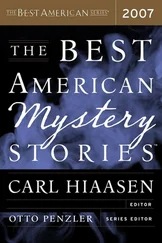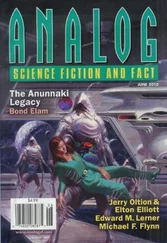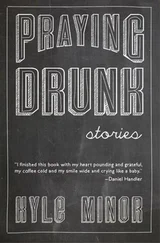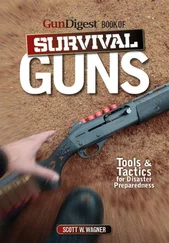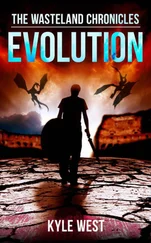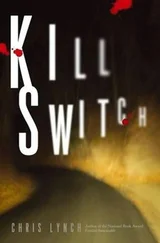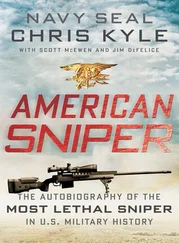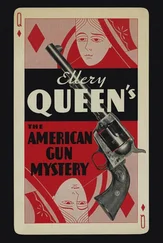Back in the White House, President Lincoln learned of the superb performance of the Spencers in combat, and decided he wanted to take another crack at shooting the gun himself.
Christopher M. Spencer arrived at the White House on August 18, 1863, bearing a new rifle as a gift. Take it apart, Lincoln suggested, and show me the “inwardness of the thing.”
Spencer complied. The next day, the two men went out to Lincoln’s target range to do some shooting. With the inventor personally demonstrating the mechanism and the four basic movements to load and fire, the Spencer performed beautifully for the president.
Lincoln cradled the rifle, lined up his shot, and fired from forty yards away. He hit the bull’s-eye on his second try, and, rapidly cranking the lever, placed four more shots close by. The inventor shot even better.
“Well,” said Lincoln good-naturedly, “you are younger than I am, have a better eye and a steadier nerve.”
Lincoln’s secretary wrote in his diary, “This evening and yesterday evening an hour was spent by the President in shooting with Spencer’s new repeating rifle. A wonderful gun, loading with absolutely contemptible simplicity and ease with seven balls & firing the whole readily & deliberately in less than half a minute. The President made some pretty good shots.”
Lincoln and the inventor parted with hearty handshakes. Now that Lincoln was personally convinced of their effectiveness, the Union military put through purchase orders that would eventually bring nearly 100,000 Spencer carbines and rifles into the Union armories and onto the shoulders of its troops. Don’t be too impressed by that number, though. It’s a tiny thing compared to the roughly two million total Union muzzle-loading rifle-muskets in the field.
Late in the war, Major General James H. Wilson led an audacious raid through Alabama and Georgia to defeat the infamous—though innovative—General Nathan Bedford Forrest at Selma, Alabama. Forrest was a scourge of the Union. He took mobile warfare to new heights and is reputed to have even killed one of his own officers following a “discussion” over orders. To beat Forrest, Wilson relied not just on superior numbers but a large number of Spencers. Using the rifle as an early “force multiplier” and employing tactics nearly as aggressive as Forrest’s, the Northern general managed to break the Confederate defenses at Selma, sending the better part of the militia there running. That forced Forrest to sue for surrender, and in effect ended the war in that section of the Deep South. Wilson gave full credit to the gun that got him there.
“There is no doubt that the Spencer carbine is the best fire-arm yet put into the hands of the soldier,” wrote the Northern general, “both for economy of ammunition and maximum effect, physical and moral. Our best officers estimate one man armed with it [is] equivalent to three with any other arm. I have never seen anything else like the confidence inspired by it in the regiments or brigades which have it. A common belief amongst them is if their flanks are covered they can go anywhere. I have seen a large number of dismounted charges made with them against cavalry, infantry, and breast-works, and never knew one to fail.”
Historians have argued that without the Union’s Spencers, the war would have gone on another six months more, with tens of thousands of additional fatalities on both sides. That point puts me in mind of a simple but I think obvious question: What would have happened if more advanced weapons like the Spencer and Sharps had been adopted earlier in the war? If our friend General Ripley had not been around to delay and doom Abe Lincoln’s early wishes, would the bloodiest war in our nation’s history have ended sooner?
I’m not the only one who’s given that some thought. A number of soldiers on both sides expressed the opinion that the Spencer or another multiple-shot, easy-firing gun would have turned the tide earlier on. Some of their comments are the sort of exaggeration you hear about Texas weather—for instance, a Michigan cavalry officer who served under Custer at Gettysburg was said to claim that Spencers would have ended the war in ninety days. But even a respected Civil War scholar like Robert Bruce thinks that advanced rifle technology would have had a huge impact on the war.
This assumes (maybe overoptimistically) that the Northern generals could have adapted their tactics to the new weapons fairly quickly. The rifle-musket was an improvement over the Revolutionary War–era musket, but both firearms led generals to mass their troops in tight lines where their inaccurate fire could be effective. That in turn dictated a series of other decisions and tactics.
You can criticize the generals for being stuck in old and inefficient ways of thinking, but step back in their boots and you start to see the world from a whole different perspective.
The average soldier in the Civil War had scant firearms training. A good number probably never even knew that their rifled weapons sent their bullets in a parabolic arc, often over their target. Then again, individual targets were often impossible to pick out through the smoke-curtained battlefield. Most of the infantrymen on both sides simply pointed their gun in the general direction of the enemy and prayed they hit something when they fired.
Change the technology and you have to change the training that goes along with it. Or more correctly, initiate some, since weapons training at the time was poor to nonexistent. A few weeks of basic work with the weapons would have done it, so long as General Ripley or one of his minions wasn’t standing by tsk-tsk ing about the number of bullets being “wasted” in practice.
The end result would have been an army of men who could hit what they were firing at, more or less, from a greater distance at a much faster rate of speed than the enemy. Given that, you could alter your tactics appropriately. The possibilities are endless with that sort of advantage. Small, mobile forces emphasizing speed like the cavalry or mounted infantry would have played an even bigger role in the fight. I know I’m expressing my prejudices as a SEAL—what are special-operations forces but mobile and fast? Still, the success of such units throughout the war practically makes the argument for me. Spencer Repeaters would have shortened the war, maybe by a lot.
But there is an old saying that’s worth remembering: Be careful what you wish for. Meaning, there’s no way to tell what the future will bring. Alter one thing, and a host of others will change. Good, bad, somewhere in the middle.
Mr. Bruce, who won the Pulitzer Prize for history, put it this way: “If a large part of the Union Army had been given breech-loaders by the end of 1862,” he speculated, “Gettysburg would certainly have ended the war. More likely, Chancellorsville, or even Fredericksburg would have done it, and history would record no Gettysburg address, no President Grant, perhaps no carpetbag reconstruction or Solid South. Instead, it might have had the memoirs of ex-President Lincoln, perhaps written in retirement during the administration of President Burnside or Hooker.” So who knows?
A friend of a good friend of mine by the name of John Navaro has shot any number of weapons from the period. Mr. Navaro is your basic weapons expert. He’s worked for movies, television shows, and the like. If you’ve watched Walker, Texas Ranger, and paid any attention to the weapons the characters are packing, you’ve seen his work—he’s the prop and weapons master responsible for getting it right. He also does a fair amount of historical reenacting as a hobby.
John really likes the Spencer, calling it a “gun before its time.” But he pointed out that maybe, just maybe, its real advantage was psychological. The way he puts it, knowing that the gun gave you more shots than your opponent couldn’t help but boost your morale. “Stronger, bolder—you just felt like you were going to come out on top,” he says. That edge is important to a fighter, especially someone in the cavalry where the tactics demand that the troopers be aggressive and hard-charging.
Читать дальше
